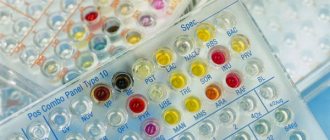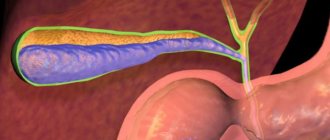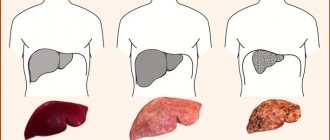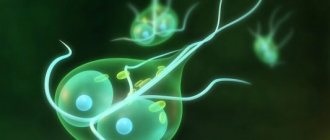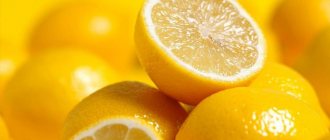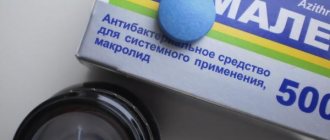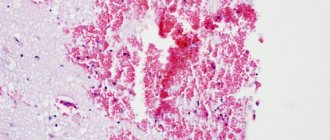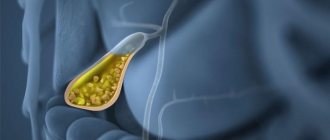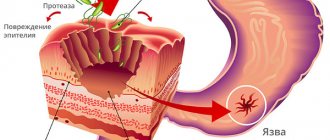Liver restoration may be required both in case of poisoning of the body, long-term use of medications, and for preventive purposes. This is not an easy task, because you will have to learn how to restore the liver using medications, following a diet and experimenting with traditional medicine. Self-cleaning and restoration can be dangerous if there are certain contraindications, so you should first consult a doctor.
Does the liver recover?
Organ tissues are able to recover even after significant damage, incl. after resection. The liver is one of the few unusual organs that can return to its original size even while maintaining 25% of its original volume. Regeneration occurs very slowly, and rapid volume restoration occurs due to an increase in the volume of the remaining cells.
Causes of liver cell destruction
Among the main reasons for the development of pathology are the following negative effects on hepatocytes:
- environmental influences (polluted water, air, low-quality products, working with harmful chemicals, etc.);
- abuse of alcoholic beverages;
- treatment with hepatotoxic drugs (antibiotics, antitumor chemotherapeutic agents);
- unhealthy diet (eating fatty, spicy, fried foods);
- physical inactivity;
- elderly age;
- malignant neoplasms;
- infectious and viral diseases.
Can the liver repair itself?
Hepatocytes have a unique property of regeneration, i.e. independent restoration of organ tissues and cells. During the regeneration process, individual hepatocytes divide several times and then return to a resting state, following certain mechanisms. Intrahepatic stem cells take an active part in the compensatory regeneration of the organ after partial fatty degeneration, hepatosis or precirrhotic tissue changes.
How quickly does it recover?
It is impossible to name the exact rate of hepatocyte recovery. According to clinical studies, how quickly regeneration occurs depends on many factors:
- use of drug therapy;
- traditional methods;
- lifestyle;
- presence of damaging factors;
- heredity;
- age.
- Causes of shortness of breath in humans. Shortness of breath - causes and treatment
- Makeup for eyes with drooping eyelids
- Pork baked in the oven: recipes
Mechanism and regulation
Confusion and confusion between the concepts of “restoration” and “regeneration” of the liver is a common phenomenon made by people without medical education. Therefore, in such publications one can find a lengthy list of folk remedies for restoring a diseased liver, while regeneration is considered inherent to a healthy organ, without inflammation and irreversible changes.
The second common misconception is the ability of the liver to independently regulate its processes. In reality, they occur not only according to internal impulses, but also according to signals coming from the whole body - hormones, cytokines, nerve impulses and metabolic commands.
There is a term that defines independent processes in the organ - liver microecology. It is used to indicate intraorgan coordination and maintain a certain relationship between:
- liver cells (hepatocytes), possessing polyfunctionality and a specific structure provided by nature for their implementation and occupying 4/5 of its mass;
- non-parenchymal structures;
- an extracellular matrix consisting of extracellular glycoproteins and a reticulin scaffold.
A deficiency of functionality develops with a decrease in parenchymal tissue or with massive death of hepatocytes. Different types of cells rearrange their activities to restore their usual architecture, in order to restore the required volume of functions and the previous lost boundaries. The liver is essential for the functioning of the body because it is involved in more than 500 important processes. For this, there are certain parameters, specific structure and abilities of the organ cells.
Liver regeneration on your own is a process that takes time and occurs within a time frame that is individual for each patient. If it lasts for a long time, inflammation develops. Its duration depends on many factors, sometimes it needs to be stimulated, and for this purpose variable methods have already been developed - operational and conservative. But in many cases this is determined by the state of the organ and the human body in which it is located. A single formula for this has not yet been discovered.
How to restore the liver
For successful and rapid regeneration of cells and tissues, it is necessary to stop the impact of destructive factors on the organ: eliminate or minimize the use of antibiotics, anti-tuberculosis drugs, limit alcohol consumption, and eat a balanced diet. The main measures taken to restore the number of hepatocytes:
- taking medications, activators of tissue regeneration function;
- use of traditional methods of treatment;
- normalization of nutrition;
- complete abstinence from alcoholic beverages.
Point of no return
When the liver is damaged by disease, drugs or toxins, it tries to repair itself - forming scar tissue called fibrosis . The more scar tissue in the liver, the less capable the organ becomes. Extensive scarring is called cirrhosis. It is the seventh leading cause of death worldwide.
The disease can progress slowly, and if detected early, the chances of recovery are quite high. The main external manifestations of the first stage of cirrhosis are jaundice, dry mouth, increased fatigue and bloating.
In the second stage, the damaged tissue begins to turn into tough bands of connective tissue. Inflammation and fibrosis slow the flow of blood through the liver.
In the third stage, the connective tissue grooves merge with each other, which leads to disruption of normal liver functions. The liver cannot store nutrients, maintain blood circulation, or break down fat. Cirrhosis at this stage provokes problems with the kidneys, spleen and heart.
At the fourth stage, the patient has extremely little chance of survival. The only hope is a liver transplant. A person feels worse every day because the liver is not able to cleanse the blood. An enlarged spleen, bone loss, and kidney failure may occur.
Medicines for the liver
Pharmacological drugs that can be used to restore hepatocytes are divided into several groups:
- hepatoprotectors, which provide protection and cell restoration;
- essential phospholipids, which have a positive effect on the synthesis of new hepatocytes;
- dietary supplements that promote the growth of functioning healthy organ tissues;
- herbal preparations that activate the synthesis of bile, ensuring its free outflow;
- amino acids that stimulate the replacement of destroyed cells with fibrous tissue.
Drug therapy using any medications for the purpose of restoring cells and tissues should be prescribed only by the attending physician. The choice of a specific pharmacological agent depends on:
- severity of the disease;
- the symptoms with which it manifests itself;
- the presence of concomitant pathologies;
- patient age and other factors.
New generation hepatoprotectors
Hepatoprotective medications are a group of medications that have a stimulating and restorative effect on the cells of the organ. Under their influence, the functioning of hepatocytes is normalized, they are protected from the negative effects of toxins, harmful foods, and alcohol metabolites. Here are some of the most popular medications from the group of hepatoprotectors:
- Gepabene. The drug belongs to the group of hepatoprotective and choleretic. The active components of the drug are plant extracts of medicinal herbs. Gepabene is prescribed for cirrhosis, hepatitis and hepatosis. The standard dosage is 1-2 tablets 1 time per day for a month. A contraindication to the use of medications is individual intolerance to the components of the medication.
- Essentiale forte. A medicine that contains essential phospholipids, which restore the structure of hepatocytes and support vital functions. Essentiale is prescribed for chronic hepatitis, 1 tablet 2 times a day for a month. Contraindications include arterial hypertension and pancreatitis. With long-term use in blood tests, the number of lymphocytes and phagocytes may decrease slightly.
- Hofitol. The hepatoprotector drug has a choleretic effect and accelerates the recovery of liver cells. The pharmacological effect of the drug is due to a complex of biologically active substances contained in the leaves of the field artichoke. Hofitol should be taken 1 tablet 3 times a day for two to three weeks.
For liver cirrhosis and hepatitis
A pathological change in the structure of an organ is called cirrhosis, and inflammatory processes are called hepatitis. These diseases lead to the gradual replacement of functional cells with connective tissue. The choice of medications for cirrhosis and hepatitis depends on the type of disease and the severity of the pathology. The most popular medications:
- Ursofalk. The medicine in the form of capsules, a hepatoprotector, has a hypolipidemic (reduces the content of some fat fractions), strong anti-inflammatory and choleretic effects. Reduces cholesterol synthesis, its absorption by the intestinal walls and concentration in bile. Reduces the lithogenicity of bile and increases the content of bile acids. The medicine for cirrhosis and hepatitis is used as follows: 1 capsule, 3 times a day. within 10-12 days. The drug is contraindicated during pregnancy and lactation.
- Karsil. A medicine based on milk thistle extract (Silybum marianum). Has anti-inflammatory and hepatoprotective effects. As a rule, it is prescribed for exacerbations of hepatitis, 2 tablets 2 times a day for the required period. Contraindications include cholelithiasis, cholecystectomy and pancreatitis.
While taking medications
Many pharmacological drugs have a toxic effect when used over a long period of time, so additional medications are prescribed that reduce the destruction of hepatocytes:
- Galstena. Combined homeopathic pharmacological preparation. The drug Galstena has an antispasmodic and hepatoprotective effect. Prescribed simultaneously with antibiotics and during chemotherapy, 1 tablet 3 times a day after meals. Among the contraindications for use are individual hypersensitivity to the components of the drug.
- Result. The drug has a powerful hepatoprotective effect and is prescribed for fatty degeneration of the organ, non-alcoholic cirrhosis and long-term use of toxic drugs. Contains sodium glycyrate. Standard dosage of the drug Rezalut: 1 tablet 1 time per day. for 15–17 days. Contraindications include pancreatitis and gastric ulcers.
- Cyclalon. The medication has choleretic, anti-inflammatory and hepatoprotective effects. Indications for use are cholecystitis caused by the use of drugs. The main active ingredient is ammonium glycyrrhizinate. Tsikvalon is prescribed, 2 tablets 1-2 times a day. Contraindications for use are pregnancy, lactation, and children under 12 years of age.
- Eggplants are like mushrooms for the winter
- Milkshake at home
- How to get ready to lose weight without failure
For the liver and pancreas
Often, disturbances in the functioning of hepatocytes are combined with chronic diseases of the pancreas. To maintain the normal functioning of both organs, the following medications are prescribed:
- Ovesol. A biologically active food supplement that regulates the functioning of hepatocytes and pancreatic cells. Indications for the use of Ovesol are pancreatitis, chronic and acute hepatitis, cholelithiasis. In addition, the drug is used to prevent these diseases. Standard regimen for using Ovesol: 1 tablet 2 times a day, regardless of meals. Contraindications include an allergy to the medicine.
- Heptral. Hepatoprotector, has an antidepressant effect. It has a choleretic and cholekinetic effect. Promotes detoxification and regeneration. Heptral is prescribed for cholestasis, 1 tablet 2 times a day for 3–5 days. Contraindication for use is pregnancy.
- Hepatocline. A medication that has a powerful anti-inflammatory and hepatoprotective effect. Helps remove waste and toxins. The medicine is prescribed for alcoholic pancreatitis, cirrhosis and viral hepatitis. Hepatocline should be taken 1 tablet 3 times a day for a month. Contraindications include individual intolerance to the components of the drug.
For the gallbladder and liver
Among the most common diseases is cholelithiasis, which disrupts the normal functioning of the gallbladder. What to take:
- Osalmid. The medication has a choleretic and antispasmodic effect. The drug stimulates the synthesis, secretion and outflow of bile. Osalmide reduces cholesterol, due to which it prevents the development of cholelithiasis, obstructive jaundice and hepatic colic. The medicine is prescribed 2 tablets 2-3 times a day, for 10-14 days. Contraindications include pancreatitis, gastric ulcer, pregnancy and lactation.
- Allohol. Pharmacological agent based on plant components. It has a strong choleretic effect and anti-inflammatory effect. Indications for the use of the drug are cholelithiasis, cholangitis, biliary dyskinesia, and gallbladder. The drug is prescribed 2 tablets 2 times a day for the required period of time. Contraindication for use is pregnancy.
To support the liver
Drugs to support the functioning of the organ are prescribed for minor disturbances in the functioning of hepatocytes. These liver recovery tablets help support the functioning of the organ:
- Silymarin. A pharmacological preparation based on herbal components that has a hepatoprotective effect. Prescribed for the prevention of hepatocyte dysfunction, in case of chronic hepatitis, the risk of developing fatty degeneration, sclerotic changes in organ tissue, 1 tablet 3 times a day after meals. Contraindication for use is hypersensitivity to the components of the drug.
- Ursosan. A medicine based on ursodeoxycholic acid, reduces the concentration of toxic substances in the blood. The medicine is widely used when treatment with hepatotoxic pharmacological drugs is necessary. The standard dose is 1 tablet 2 times a day. before meals. Contraindications for use include pregnancy and lactation.
Conclusion
Alcoholism affects all organs. To prevent the liver from refusing to function, it is necessary to take measures aimed at improving the health of the body as quickly as possible.
The process is quite complex, lengthy and labor-intensive. This is why many doctors do not recommend self-treatment. It is necessary to seek medical help as soon as possible.
An experienced doctor will conduct a comprehensive diagnosis,, if necessary, offer detoxification therapy, and select medications.
The liver is the largest internal organ in the human body. Its weight reaches 1.5 kg, and the number of functions can reach up to hundreds. Because of this, any changes in the functioning of the liver affect the quality of life.
Experts have determined that even one third of the organ is enough for its complete regeneration. With minimal effort it can be easily restored. The liver is able to return to full function after prolonged exposure to alcohol, frequent use of antibiotics and surgery. Specific results depend on the general health of the patient, his age and conscientious adherence to the recommendations of the attending physician.
The organ suffers the most when consuming alcoholic beverages. To process ethanol breakdown products and remove them, it works for wear. Hepatocytes - liver cells - are affected, but the degree of deformation depends on the amount of alcohol consumed. With one-time use, it will take several days to process ethanol and remove toxins. Most often, the person feels comfortable the very next day.
The greatest danger to the liver is alcoholism, in which patients are not aware of the quantity, quality and time of drinking alcohol. At the very beginning of pathological changes, the body copes on its own. As the pathology progresses and with frequent binges, it takes from a week to several months to recover. In the final stages, the affected areas are replaced by scars, after which drug treatment is impossible.
As soon as a person feels discomfort in the right hypochondrium, he should visit a doctor. After making a diagnosis, the specialist will select adequate treatment. But to achieve results you need to stop drinking. After quitting alcohol at the initial stage of the disease, the liver recovers within a few months. If tissue degeneration occurs, rehabilitation takes years.
When self-medicating with antibacterial agents on the fifth day of use, dermatitis, allergic reactions, the development of dysbacteriosis and impaired liver function are possible. The body perceives incoming medications as toxins that need to be urgently removed from the body. To do this, more bile is released, which can cause digestive problems and the formation of stones.
With a long course of antibiotic therapy, the liver cannot cope with the load. The accumulation of toxic substances begins, which poison the body. Because of this, drug-induced hepatitis may develop after antibiotics. If the drugs were too strong, there is a high risk of severe necrosis and cirrhosis. Therefore, all antibiotics must be prescribed by a specialist, taking into account the dynamics of the disease and the need to use a particular remedy.
Liver restoration products
To prevent diseases of internal organs, it is recommended to avoid harmful foods. In addition, a proper diet helps restore liver cells. Some simple products will help support the normal functioning of not only hepatocytes, but also all organs of the gastrointestinal tract:
- Pumpkin. This vegetable is a natural hepatoprotective agent; it contains a large amount of pectin. The substance has a beneficial effect on the functioning of hepatocyte cells, restoring their phospholipid layer, helps get rid of toxins and removes ursodeoxycholic acid from the body. It is recommended to eat boiled and baked pumpkin at least 3-4 times a week.
- Persimmon. Regular consumption of this fruit reduces the risk of developing morphological pathologies of the gallbladder due to its high fiber content. Persimmon reduces the level of high-density lipoproteins, due to which the blood vessels are cleared of cholesterol plaques. By consuming the fruit, you can alleviate the manifestations of hepatosis. The high content of vitamin C helps improve intracellular metabolism and reduce swelling.
- Buckwheat grain. Contains a large amount of iron and B vitamins, which have antioxidant and lipid-lowering effects. Buckwheat is used to prevent diseases of the gastrointestinal tract and to prevent steatohepatitis.
What diet promotes recovery?
Liver recovery is a long process. For example, in case of cholelithiasis, it is necessary to take bile acids for two years (and this does not guarantee recovery), and throughout the entire course of medication it is necessary to strictly follow a diet and completely abstain from alcohol. Therefore, it is better to adhere to a healthy diet throughout your life than to follow a strict diet later and give up your favorite foods.
To improve liver function, you do not need to dramatically change your diet, but rather gradually give up harmful foods so that the body can adapt to new conditions. For diseases of the hepatobiliary system, treatment table No. 5 is recommended.
It involves chemical and mechanical sparing of the digestive tract and reducing the volume of portions. Eating small meals frequently will help normalize bile secretion. The liver secretion will be synthesized in small portions, so it will not linger in the bile ducts.
Water is required to cleanse the liver. A person should drink 30 ml of liquid per kilogram of weight per day, that is, if the weight is 60 kilograms, then you need to drink 1.8 liters of water per day. Any free liquid (soup, tea, juice, compote) is taken into account. Water will speed up metabolism, reduce bile lithogenicity, and flush out toxins.
Foods containing harmful cholesterol should be removed from the diet, since it is deposited on the blood vessels and leads to their blockage, as a result of which normal blood flow is disrupted and the organ is poorly supplied with blood. If the liver does not synthesize enough enzymes, then lipid compounds precipitate, and over time, stones form in the gland itself or the gall bladder, which begins the inflammatory process.
It is important that meals are regular and at the same time, so that a conditioned digestive reflex is developed.
Foods containing fiber, polyphenol, phytosterol, resveratrol, and unsaturated fatty acids will help reduce cholesterol levels. These substances are found in grapes, green tea, tomatoes, plums, nuts, citrus fruits, beans, figs, cereals, oatmeal, vegetables, vegetable oils, so they must be included in the diet to strengthen the liver.
Diet to cleanse the liver
Fatty, fried, spicy foods, sour foods, smoked foods, and food additives put extra stress on the liver, so you should avoid them altogether. Vegetables and fruits have a good effect on the functioning of the gland, as they contain pectins.
To quickly restore the liver you need to eat apples, seaweed, pumpkin, quince, corn, vegetable oil (especially corn and olive), parsley, dill. Fermented milk products (cottage cheese, yogurt, kefir, yogurt, fermented baked milk, mild cheese) will help remove toxins from the intestines, which means they will relieve the load on the gland.
Liver regeneration will happen faster if you follow the following rules:
- hold a fasting day once a month;
- eat small meals;
- refuse fried and smoked foods;
- replace animal fats with vegetable ones;
- eat more fresh vegetables, herbs, fruits, berries;
- include healthy foods in your menu every day;
- remove fast carbohydrates and refractory fats from the diet.
With elevated cholesterol levels, lipid metabolism is disrupted and obesity develops
Vitamins
Hypovitaminosis (lack of one or more vitamins in the body) inhibits the restoration of hepatocytes and contributes to the development of chronic diseases. To prevent the occurrence of pathologies, doctors prescribe vitamin complexes:
- Gepagarth. Dietary supplement containing membrane-stabilizing phospholipids and a complex of vitamins C, group B and PP. The drug protects hepatocytes from destruction. Among the advantages of the drug, its targeted action is noted, and among the disadvantages are the high cost and the need to take the drug for a long time to obtain the desired effect.
- Legal. The main active ingredient of this medicine is obtained from extracts of the fruits of the milk thistle plant. Legalon contains vitamins E, retilone and riboflavin (B2). The advantage of the drug is its hepatoprotective effect, which ensures rapid restoration of organ cells, but the disadvantage is its high cost.
- Complivit. Combined balanced general strengthening vitamin and mineral complex. Helps improve cell metabolism and accelerate the synthesis of phosphoglycerides. The advantage of this medication is its versatility, but the disadvantage is a large number of side effects if used uncontrolled.
What destroys the human liver?
The first thing doctors prescribe for any liver problems is diet. After all, we are what we eat, and most of all this expression is true regarding the hepatobiliary system of the body.
Poor nutrition
Fatty foods, namely duck and goose meat, as well as pork and lard, cause great harm to the liver. Don’t think that you can cheat by preparing a rich broth and removing the meat from it. The soup will no longer be dietary and will still be harmful to the liver. Such a hearty culinary delight has the same effect on her as meat in its pure form.
But it’s not only deli meats that are among the foods that put extra stress on the liver. These also include fatty fish (mackerel, herring, halibut, eel and sturgeon). Keep in mind that some types of fish significantly exceed even pork in terms of calories.
The consumption of incompatible foods also greatly impedes the preservation of the liver in the form in which it will be considered completely and completely healthy. It is not recommended to eat protein and carbohydrate foods at the same time. The fact is that the former requires acidic enzymes for its digestion, and carbohydrates need alkali.
But if fatty meat and fish can occasionally be baked or steamed, combined with a light side dish of vegetables, then there are foods that are strictly not recommended.
The use of preservatives also negatively affects the condition of our liver. Try to eat as little pickled vegetables, a variety of pickles, vinegar, horseradish, ketchup and smoked meats as possible. Their entry into the body provokes the release of an increased dose of bile. This happens because only such an amount can cope with the breakdown of harmful substances contained in these products.
The results of frequent presence of excessive amounts of bile in the body can be quite disastrous. Excess bile can stagnate in the ducts, which actually causes the formation of gallstones.
Interesting fact! A formation in the form of a small grain of sand can literally turn into a stone in just 6 months, the diameter of which can reach 1 cm.
What else to permanently cross off from the list of usual foods:
- Don't consume carcinogens! Have pity on yourself and your liver, because for it this is real poison.
- Try to eliminate refined sugar. Replace it with natural (not synthetic) sweeteners.
- The best way to finish off your liver is to regularly eat refined carbohydrates (white bread, pasta, pancakes, pies and other flour products). So if you don’t want to make the situation worse, limit yourself in this too.
Bad habits
Everyone knows that alcohol is the worst enemy of our body as a whole, and even more so of the liver. Not only does it cause damage by destroying the brain's nerve cells (neurons) mentioned above, but it also has detrimental effects on the liver.
But, despite this, we continue to delight ourselves with another dose of our favorite alcoholic drink, completely forgetting that with every sip, hepatocytes die. So if you decide to bring your body back to normal and are making sure that your liver recovers, albeit gradually, try to completely give up alcohol.
Smoking also takes its toll on the liver: everyone knows that nicotine has the property of constricting and destroying blood vessels. With the contraction of numerous vessels and capillaries of the liver, metabolic processes deteriorate, bile stagnates, which can lead to dysfunction of the organ and the formation of stones. Well, let's not forget that smoking significantly increases the risk of cancer.
We can talk for a long time about the dangers of drugs, especially synthetic ones. They destroy not only the liver and other internal organs, but also a person’s entire life. But first of all, the load goes to our “filter,” so drug addiction is almost guaranteed to kill your liver.
Wrong lifestyle
We can struggle long and hard with bad habits and our attachment to tasty, but not at all healthy foods, but even if we limit ourselves in many ways, we must not forget that the wrong lifestyle decides a lot. Diet alone cannot change the way the body works if a person does not get enough sleep, physical activity, or fresh air.
A sedentary lifestyle can cause liver cell destruction. Some doctors even consider the presence of hemorrhoids to be the first sign that something is wrong with your liver.
How to help the liver with folk remedies
To improve the recovery of liver cells in chronic viral diseases and toxic lesions, it is recommended to use traditional medicine recipes in addition to the main treatment. Here are some of the most popular remedies:
- Milk thistle oil. To support the work of hepatocytes, unrefined milk thistle oil is used 1 tsp. several times a day during meals for two to three weeks. If necessary, the course of treatment is extended or repeated after some time. It is not recommended to use milk thistle oil for people who suffer from pancreatic diseases.
- Honey with cinnamon. To prepare this folk remedy, you need to take a glass jar, 200 g of honey and 2-3 tablespoons of ground cinnamon. Mix honey and cinnamon and place in a jar. Place in a dark place for 7-10 days. To restore liver cells, you should take 1 tbsp. 3 times a day for a month. Use with caution for people prone to allergies and diabetes.
- Alcohol-water tincture of corn silk. A remedy made from corn silk will help restore the liver at home. To prepare it, you need to take 100 g of the healing agent and add 200 ml of vodka and 100 ml of water. Leave the resulting mixture in a cool, dark place for two weeks. To restore liver cells, you should take 1 tsp of tincture. twice a day for a month. The product is contraindicated for use by people suffering from chronic heart and vascular diseases.
- Turmeric with immortelle herb. Turmeric significantly accelerates the regeneration of hepatocytes, and immortelle extract has a powerful antitoxic effect and prevents the development of fatty dyskinesia. To prepare a folk remedy, you need to take a quarter teaspoon of dry spice, a tablespoon of crushed immortelle and pour boiling water over them. After three hours, strain the drink and take 2 tablespoons per day for a week. Immortelle herb can be replaced with vodka or artichoke.
- Oat jelly. Oat jelly will help restore liver cells. The cereal must be poured with water and boiled, then cooled. Strain the resulting mixture and place in a warm place for a day. At this time the solution should thicken. You can add salt, sugar, cinnamon or citrus juice to the resulting jelly. This folk remedy has a beneficial effect on the biliary tract and has an anti-inflammatory effect on the mucous membrane of the gastrointestinal tract.
- Freshly squeezed beetroot and carrot juice. To prepare this product, you need to mix freshly squeezed carrot and beet juice in a 3:1 ratio, then let it brew in the refrigerator for 1-2 hours. It is recommended to take the drink three times a day after meals. If desired, you can add lemon, sugar or honey. Carrots have a choleretic effect, relieve spasms of the ducts, and beets prevent the formation of stones. People with gastric ulcers, duodenal ulcers, and chronic gastritis should dilute the juice with boiled water.
Remember that restoring the liver with folk remedies does not replace full-fledged drug treatment. The use of alternative medicine recipes has a number of contraindications, and before using them it is necessary to consult with a specialist and conduct laboratory and instrumental studies of the gastrointestinal tract.
What to do if you use it for a long time?
Is it possible to regain health after drinking? Here you will first need to visit a doctor who will conduct a full examination and prescribe appropriate treatment. But the main measures are also diet and complete exclusion of alcohol-containing drinks. In addition, it is necessary to immediately find out why the liver hurts after alcohol. The reasons are different, the most dangerous among them are hepatosis with complete replacement of healthy tissues with fat and cancer, which in most cases can no longer be treated.
Food
Reliable liver protection from alcohol involves proper nutrition:
- fruits, fresh juices based on them, vegetables;
- dietary meats;
- kefir;
- skim cheese.
Spicy, very fatty, overly salty, and mayonnaise should be excluded from the diet. It is recommended to steam all dishes; boiled or baked foods and soups made from lean meat will be beneficial. It is better to avoid hot or very cold foods for the entire period of treatment.
How long does it take for the liver to recover? The time depends on the body’s ability to remove toxic substances. To speed up this process, it is necessary to increase the secretion of bile, for which cauliflower, avocado, fresh herbs, broccoli, zucchini, turnips and other products will be useful.
Very carefully you need to include in your diet foods such as garlic, radishes, horseradish, which can cause spasms and irritation of internal organs.
Plant and mineral waters to protect against toxins
The best medicine for the liver in alcoholism is prevention. Before drinking alcohol, it is recommended to drink a tablespoon of regular unrefined vegetable oil. Such simple measures will reduce the rate at which alcohol is absorbed and protect the body from the negative effects of toxins.
Alkaline mineral waters are great in the morning to restore normal well-being and speed up the recovery of the body. The mineral water alkalizes the excessively acidic environment of ethanol, neutralizes its negative effects on the body, and makes other products for liver restoration more effective.
Medicines that relieve intoxication
If after drinking alcohol your right side hurts under the ribs, then you should immediately contact a specialist for diagnosis and treatment. Medicines for treating the liver include Karsil, Essentiale, Hepatrin, Silymarin and others. In especially severe cases, detoxification measures are required, drugs are prescribed to activate the secretion of bile, the production of enzymes and the complex protection of the body. Liver tablets after alcohol are taken strictly according to the regimen prescribed by the doctor. It is absolutely forbidden to change the regimen, self-medicate or start drinking alcohol at this time.
Folk recipes
Folk remedies include the following products:
- milk thistle extract;
- infusions of herbs such as field mustard, cinquefoil, wormwood, dandelion;
- vegetable juices from carrots, cabbage, herbs, pumpkin.
In addition, you can use the following folk remedies - rosehip decoctions, infusions of birch buds, and oat grains, taken daily.
Birch bud infusion helps cleanse the liver
How to restore the liver after prolonged alcohol consumption? Milk thistle extract is recommended for people over 40 years of age; you can buy it ready-made or brew an infusion yourself. The course is 3-4 weeks every year (the product is used for recovery, as a preventive measure).
You can also take milk thistle seed powder by mixing a tablespoon with a glass of kefir or green tea. The course of treatment is the same as when taking the tincture; already two weeks after the start of treatment, you can notice an improvement, dark circles under the eyes disappear, and liver function improves.
For pain in the liver, pumpkin juice helps well, which you can drink half a glass three times a day. It is very simple to obtain such juice; you need to cut off the top of a small pumpkin, remove the seeds with the core, and fill half the remaining space with honey. Soon there will be juice that is collected for drinking.
Cinquefoil helps improve liver function after alcohol damage; to do this, pour 0.5 liters of vodka into 50 grams of dry cinquefoil root and leave for about 3 weeks. You should drink the tincture 30 drops three times a day before meals, diluting the product in plain water.
Self-healing of the liver in cirrhosis
Cirrhosis of the liver
While studying changes in the structure and functions of the liver in cirrhosis, researchers drew attention to the fact that in the presence of cirrhosis after surgery, the volume of the organ was not completely restored, and normalization of biochemical parameters occurred later.
Thus, when 65% of the liver volume was removed in cirrhosis, the increase in the organ by the end of the year was 95%, and when 30–35% of the organ was removed, the liver grew to 64%. After a segmental ectomy, which accounted for 15% of the organ, the increase by the end of the year was 33%. Moreover, during similar operations without concomitant cirrhosis, liver growth and functionality rates were significantly higher.
With extensive resection, the maximum increase was observed in the first 20 days, followed by a decrease by the end of the one-year period after surgery. Thus, cirrhosis not only kills hepatocytes and destroys liver parenchyma, but it also suppresses the regeneration process.
Liver regeneration after transplantation
Liver regeneration
During the research, doctors noticed that the liver subtly reacts to both a deficiency and an exaggeration of its size. The transplanted part of the gland, if there is a larger volume, does not increase, but, on the contrary, can decrease due to the destruction of hepatocytes. A small liver, on the contrary, gradually grows to the size required for a given patient. During observations of patients who underwent heterotopic transplantation, that is, another lobe of an organ was transplanted that did not correspond to the affected one, as if for an auxiliary purpose, doctors drew attention to an interesting fact. When the own, affected part of the organ healed and was restored, the transplanted part began to atrophy.
Symptoms and complications
Malfunctions of the liver provoke other dangerous diseases.
Impaired liver function can lead to the following diseases:
- pathologies of the cardiovascular system;
- pancreatitis;
- diabetes;
- gallbladder diseases;
- deviations in the functioning of the endocrine system.
If a pathological process develops in the liver, the patient will experience symptoms such as:
- chronic fatigue;
- painful sensations in muscles and joints;
- belching with an unpleasant taste;
- rash on the body;
- yellowing of the skin;
- anemia;
- pain in the right hypochondrium.

